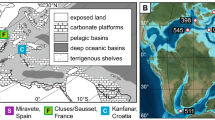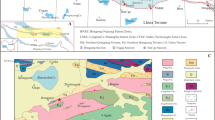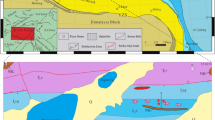Abstract
THE purpose of this letter is to describe the biostratigraphy of a deep-sea core of late Pliocene to early Pleistocene age from a middle latitude area. This core contains a succession of Globorotalia tosaensis Takayanagi and Saito and Globorotalia truncatulinoides (d'Orbigny) distinctly different from that reported from tropical deep-sea sediments where it has been used to delineate the Pliocene–Pleistocene boundary. Banner and Blow1,2 use the appearance of Globorotalia truncatulinoides in the definition of their zone N22 and state that this zone occurs in the lower part of the stratotype Calabrian. Bayliss3, however, found G. truncatulinoides to be rather rare in the type section, occurring for the first time 135 m above the base of the exposed section and 30 m above the marker designated as the base of the Calabrian by Gignoux4. Based on the assumption that G. truncatulinoides does in fact appear for the first time within the Calabrian, its first appearance in tropical deep-sea sediments has been taken to represent the Pliocene–Pleistocene boundary5–7. This conclusion received support in the discovery by Berggren7 of a possible phylogenetic transition between Globorotalia tosaensis and G. truncatulinoides in a tropical Atlantic deep-sea core. Magnetic stratigraphy in this core indicated the age of a stratigraphically defined Pleistocene to be close to 2 million years.
This is a preview of subscription content, access via your institution
Access options
Subscribe to this journal
Receive 51 print issues and online access
$199.00 per year
only $3.90 per issue
Buy this article
- Purchase on Springer Link
- Instant access to full article PDF
Prices may be subject to local taxes which are calculated during checkout
Similar content being viewed by others
References
Banner, F. T., and Blow, W. H., Nature, 208, 1164 (1965).
Banner, F. T., and Blow, W. H., Micropaleontology, 13, 183 (1967).
Baylies, D. D., Lethaia, 2, 133 (1969).
Gignoux, M., Ann. Univ. Lyon, 36, 28 (1913).
Glass, B., Ericson, D. B., Heezen, N. D., Opdyke, B. C., and Glass, J. A., Nature, 216, 437 (1967).
Parker, F. L., Bull. Amer. Paleont., 52, 115 (1967).
Phillips, J. D., Berggren, W. A., Bertels, A., and Walls, D., Earth Planet. Sci. Lett., 4, 118 (1968).
Smith, L. A., Gulf Coast Assoc. Geol. Soc., Trans. (in the press).
Parker, F. L., Sci. Rep. Tohoku Univ. Soc. Ser. (Geol.) Spec., 4, 71 (1960).
Blackman, A., and Somayajulu, B. L. K., Science, 154, 886 (1966).
Geitzenauer, K. R., Nature, 223, 170 (1969).
Author information
Authors and Affiliations
Rights and permissions
About this article
Cite this article
KENNETT, J., GEITZENAUER, K. Pliocene–Pleistocene Boundary in a South Pacific Deep-Sea Core. Nature 224, 899–901 (1969). https://doi.org/10.1038/224899a0
Received:
Revised:
Issue Date:
DOI: https://doi.org/10.1038/224899a0
This article is cited by
-
Globorotalia truncatulinoides Datum Plane: Evidence for a Gauss (Pliocene) Age in Subantarctic Cores
Nature Physical Science (1973)
Comments
By submitting a comment you agree to abide by our Terms and Community Guidelines. If you find something abusive or that does not comply with our terms or guidelines please flag it as inappropriate.



